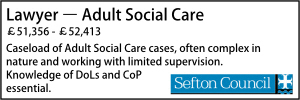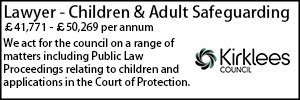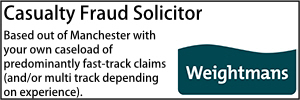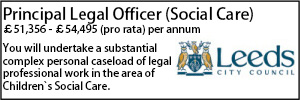Appealing the outcome of a fact-finding hearing in care proceedings
Graeme Bentley examines the implications for local authorities and children’s services practitioners of a recent Court of Appeal decision in which all parties supported an appeal against a Recorder’s fact-finding judgment, but, unusually, the Court dismissed it.
- Details
In Re K and G (Care Proceedings: Fact-Finding [2025] EWCA Civ 910, all of the parties supported an appeal. Despite this, the appeal was refused. The Court acknowledged that it was unusual for it to use its powers in this way, but that this was an appropriate case [3].
Background
The Court of Appeal was dealing with an appeal by the local authority against the outcome of a fact-finding hearing concerning injuries to a five-month-old child noted in May 2023, namely bruising to both cheeks, the left shoulder, left ear and left calf. It was suspected that injuries to the child's face and shoulder were the result of bite marks. During the initial investigation, the mother produced photographs of similar earlier injuries dating from February to April 2023.
The Court criticised what it described as “alarming and unacceptable” delay of over two years during which the children had been living with family members and the parents had separated. It regarded the matter as not complex and involving matters at the less serious end of the scale. The injuries were described as very concerning and unpleasant, but forensic investigation of them ought not to have been particularly complicated. It did not look into the reasons for delay [4].
Following the issue of care proceedings in June 2023, four experts were instructed: a forensic and dental surgeon, an odontologist, a paediatrician and a haematologist. From the last of these, it was ascertained that there was no abnormal propensity to bruising. The other three gave evidence at fact finding.
The Recorder hearing the fact finding found that the injuries to the cheeks and shoulder (and the injuries in the photographs) were bite marks and the ear injuries were unexplained. She did not, on the totality of the evidence, feel able to identify a perpetrator from the parents leaving them both in the pool.
Grounds of Appeal
All parties joined the local authority in seeking to appeal the decision prior to further case management. The local authority’s appeal was based not upon failure to find a perpetrator but upon the Recorder failing to reference its schedule of findings or to amplify the findings sought, failing to analyse the evidence or to apply the correct legal framework. It said that there had been no solid factual matrix to enable a thorough risk assessment.
The Guardian, while not agreeing the need to be bound by the schedule of findings, said that there had been an inadequate analysis of the perpetrator and of the ear injury; it was said that there had been no clear assessment of parental credibility to weigh against the medical evidence. Mother argued that father should have been found to be the perpetrator. Father supported the local authority, but leading counsel agreed at the request of the Court to identify the arguments against appeal.
The Court of Appeal ruled that:
- In some cases, the judge structures the judgment in line with the threshold document, but he or she is not obliged to do so. It all depends on the facts and issues in the case. Provided the judge in a fact-finding hearing ensures that the parties have a fair hearing and delivers a judgment that covers the ground within the known parameters of the case, it does not matter that the structure of the judgment departs from the threshold document. To insist otherwise would be to impose on judges an unnecessary and unhelpful formalistic approach. It will, however, be helpful if the findings made in the judgment are distilled by counsel into a schedule, or similar document, and appended to the court order approved by the judge [45].
- If the judge has omitted to deal with an aspect of the findings sought by the local authority, the first option for the parties is to invite the judge to clarify the reasons. In doing so, they must, of course, comply with the guidance given by the Court in the series of cases culminating in Re YM (Care Proceedings) (Clarification of Reasons) [2024] EWCA Civ 71, including the observation at paragraph 90(1) that a judgment does not need to address every point that has arisen in the case. “The court should only be asked to address any omission, ambiguity or deficiency in the reasoning in the judgment if it is material to the decisions that have to be taken in the proceedings.”[46].
- If (as argued by the local authority) the matters that it identified amounted to omissions or deficiencies in the reasoning which were material to the decisions about the children’s future, it would, of course, be open to the Court to allow the appeal. In this case, however, such a course would be unnecessary and wrong [48].
- The judgment was not either insufficiently detailed nor lacking coherence. Applying Fage UK Ltd v Chobani UK Ltd [2014] EWCA Civ 5 at paragraph 115, the obligation of the Judge was to give his reasons in sufficient detail to show the principles on which he has acted and the reasons that have led him to his decision. They need not be elaborate. There is no duty to deal with every argument presented by counsel in support of their case. His function is to reach conclusions and give reasons to support his view, not to spell out every matter as if summing up to a jury. The analysis here was sufficiently clear and cogent to enable any reader to understand the basis for the decision. The reasons were not expressed as they would have been in a written judgment (this being a judgment delivered from notes) and there were therefore some loose ends, but not ones which, when examined, cause the judgment to unravel [50]. The Recorder had not failed to take account of credibility, had reached her conclusion on a perpetrator after setting out an analysis of the evidence and her decision was unassailable on that point [52]. It was arguable that she should have expanded on her reasoning about the ear injury, but her reasoning was sufficient. While she might have considered the ear injury before the bite marks, the court was unconvinced that this would have had an impact on identifying a perpetrator [54].
- While there was no specific finding on allegations of failure to protect by either parent:
- The allegations were added to threshold after the evidence. The court did not have a transcript of this in order to take a view, but it was not a feature of the local authority case at the outset.
- As a perpetrator could not be identified, it was not surprising that the Judge had not gone on to make a finding on failure to protect.
- It was likely that, in finding it impossible to determine where the truth lay, the Judge had found her ability impeded to make a finding on this issue. Given the findings that there were bite marks and that the perpetrator was either the father or the mother, it would be unnecessary and disproportionate to allow the appeal on this point.
- As was said in Fage at paragraph 114, appellate courts have been repeatedly warned, by recent cases at the highest level, not to interfere with findings of fact by trial judges, unless compelled to do so. This applies not only to findings of primary fact, but also to the evaluation of those facts and to inferences to be drawn from them. This principle of judicial restraint by appellate courts extends to decisions by judges at first instance that they are unable to make findings of fact or, although they are able to make findings, unable to conduct a complete evaluation or to draw the inferences from the findings suggested by the parties. It ought to be possible for a skilled risk assessor, perhaps using the “Resolutions” model, to work with the family on the basis of the Recorder’s findings and judgment and produce an assessment that will enable the court to conclude these proceedings with a clear plan for the children’s future care. [60]
A Judge will not therefore be overturned simply for failing to “stick to the script” and structuring their findings around the local authority’s schedule. The first option, where there are perceived deficiencies in the judgment, is not necessarily to appeal but may be to seek clarification in the first instance. It is long established that the Court of Appeal will not substitute its own view of the findings. If, however, it is argued that the Judge failed to apply the evidence, consideration may need to be given to obtaining a transcript of it.
It is not necessarily impossible to conduct a risk assessment in the absence of findings on all the issues sought. The Resolutions model explores how families may be able to devise a safe plan for the children without there necessarily being a finding or an admission. While it will not be suitable for every case, it is approved as a model and ought to be borne in mind.
Key takeaways
- Judges are not bound to structure findings slavishly around the local authority’s schedule.
- Where deficiencies are perceived, clarification should usually be sought before appeal.
- The Court of Appeal will not substitute its own evaluation where a Recorder has given a sufficiently reasoned judgment.
- Risk assessment models, such as Resolutions, may assist even where all findings sought are not made.
Graeme Bentley is Principal Solicitor in Invicta Law’s Child Protection team and an Accredited Member of the Law Society’s Children Panel.
































